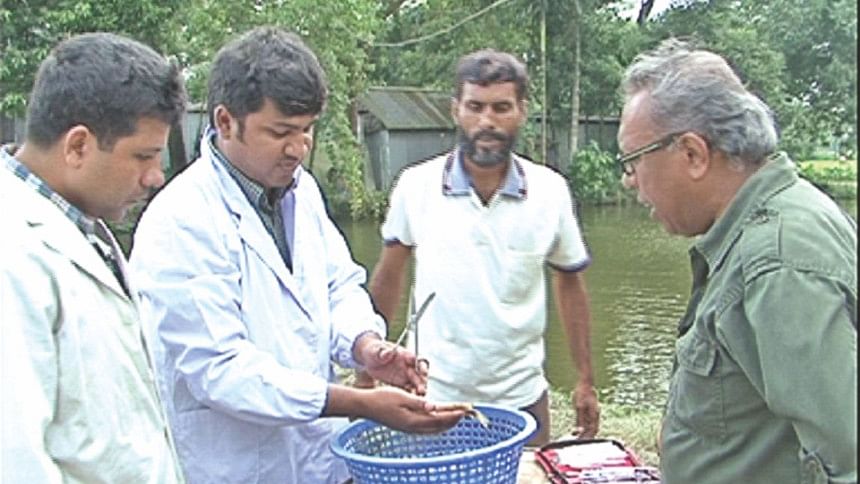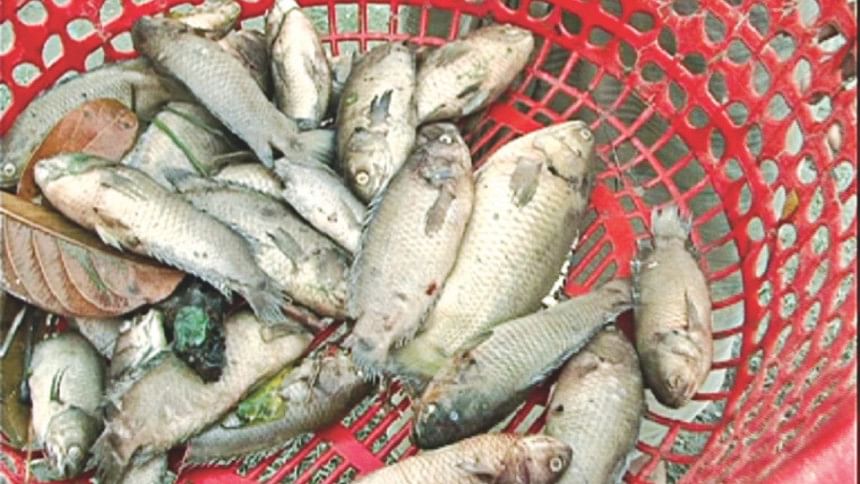What is killing Vietnamese koi?

Over the past fifteen years, Bangladeshi pisciculture has undergone a revolution, bringing the nation to fourth position globally in the farming of freshwater fish. For the last several years, koi fish, first Thai koi and subsequently 'all female' koi, have shared centre stage; but from three years ago it was Vietnamese koi that took the mantle of most exciting koi breed, with the promise of the highest profits. The Vietnamese koi industry has blossomed since, without a hitch, until now.
This year, Vietnamese koi farmers have lost millions of taka. To find out exactly what is going on, I spoke with the pisciculturalists of Mymensingh, the district that has long been one step ahead of others in freshwater fish production.
"I couldn't sell any fish yet," says pisciculturalist Rahim of Mymensingh's Fulbari upazila. "All the adult koi are dead, only the small ones are left."
His colleague Jabbar from Mymensingh Sadar upazila says he started with approximately 350,000 Vietnamese koi fry but only around 50,000 have survived.
In nearby Trishal upazila, Jamil tells of similar woe. "When the fish were only a month old they started to die. On many a morning I found dead koi floating."

The problem is not unique to Mymensingh. In far-off Jessore, Vietnamese koi farmers have lost nearly 500 million taka district-wide.
"I think a virus is responsible," says Rabiul from Jessore Sadar's Barmanpara, personally nearly 20 million taka worse off.
As yet, no one is entirely sure what disease is wreaking the havoc. Nor is it clear where the malady is coming from. Some farmers blame fish feed companies for mixing antibiotics and growth promoters into their products while others believe the source lies with contaminated fry.
In support of the former theory are reports of better results when fish feed is withdrawn. "When we stopped adding fish feed," says Idris of Mymensingh's Muktagachha, "instance of disease also ceased. Whenever I start adding the feed the deaths recommence."
Yet commercial fish food production companies have ruled out the feed as the problem's source. "If fish are given feed when they're already sick," says the marketing manager of Mega Foods Ltd, Kamrul Islam, "they'll suffer digestive problems."
Many farmers have tried medicines but found none that work. Neither did putting extra water into ponds help.
Dr Yahya Mahmud, the director of administration at the Bangladesh Fisheries Research Institute, says that overproduction and abnormal fry with limited disease immunity may cause excessive mortality.
But he also identifies a strain of bacteria, rather than a virus, as a likely culprit. "The bacteria we found in Vietnamese koi," he says, "were also found in tilapia fish. They seem to have fallen victim to the same disease over the past few years." The disease presents itself as reddish fins, indicative of haemorrhage.
Another possible cause identified by Dr HM Kohinoor, a senior scientific officer at the Institute, is the push by some farmers to secure quick profits. "Farmers breed the fish in February to sell in March," he explains, "which leaves the water very impure with increased ammonia, which kills fish."
Scientists have experimented with 25 types of antibiotics recommended by the Food and Agriculture Organisation of the United Nations to find that most have become redundant. Even doxycycline couldn't prevent the bacteria's spread.
I take Dr Kazi Azimuddin and Sirajum Munir of the Institute to one of the worst affected villages, Alalpur, to examine newly dead fish. We soon find a koi bleeding from the belly, which points to the fish's organs being infected. Dissection reveals a blackish, swollen liver.
Yet water tests also reveal problems: there is an excess of alkalinity, a staggering 2.4 mg per litre of ammonia with normal levels being 0.02 mg per litre, and lower than expected oxygen.
Unlike with paddy seeds, as yet the fish farming industry does not benefit from a certification system for fry. Farmers routinely exceed recommended stocking density rates in the hope of greater profit, and hatchery and poultry feed manufacturers face little effective regulation. The next step in capitalising upon the country's considerable fish farming success should involve better practises in these areas. Such efforts might prove effective in solving the problem of Vietnamese koi deaths.
Such improvements are critical to the industry, with many pisciculturalists already choosing to leave the promising breed behind.

 For all latest news, follow The Daily Star's Google News channel.
For all latest news, follow The Daily Star's Google News channel. 



Comments